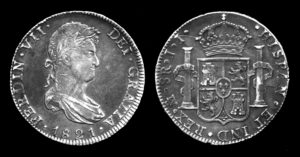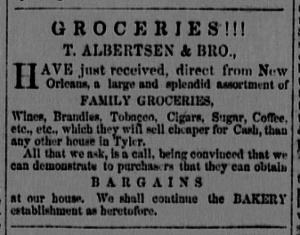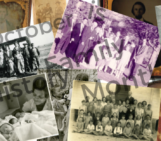How far would a dollar stretch in 1860 Tyler?
First of all, did they have a dollar as we know it? Before the Civil War the only money used was gold and silver coins referred to as specie. In 1862 president Lincoln authorized congress to print currency. Foreign coins were widely circulated in the colonies. One of those was the Spanish dollar also known as pieces of eight. Silver and gold coins were exchanged by weight. People also bartered, exchanging goods and services for other goods and services.

Silver Eight Royals Coin of Ferdinand VII of Spain, 1821
Source of picture: By Coinman62 at English Wikipedia – Transferred from en.wikipedia to Commons., Public Domain, https://commons.wikimedia.org/w/index.php?curid=11936261
For this example, we will look only at the census year 1860. Using the categories of Real Estate and Personal Estate, we are able to estimate the personal wealth of some of the early citizens of Tyler.
The census taker was to ask the respondent to summarize the value of the all their land and houses wherever they may be located and whether or not they owed money on them. The question of personal property was similar and included all personal wealth.
The first example is George Washington Chilton (1828 – 1884) born in Kentucky, a lawyer, living in Tyler in 1860. He is listed as having Real Estate valued at $2,000 and Personal Property at $3,500. In today’s dollars that would equate to $100,518.
Next a merchant, Tom Albertson (1832-1893), born in Norway who came to Tyler about 1856. He worked with his father and brothers as a baker and shoemaker. His Real Estate was valued at $2,000 and Personal Property valued at $1,000. In today’s dollars that would equate to $86,158.
Finally, a farmer, William Green (1815-1879), born in North Carolina, came to Tyler about 1850. He owned property on Old Bullard road and was a commissioner for the city. His Real Estate was valued at $3,500 and Personal Property at $1,500. In today’s dollars that would equate to $143,597.
So, what does this mean? It is a way to look at the relative net worth of a family. But what could they buy with those dollars? That might tell us what the dollars were worth.
Using an inflation calculator we see that that one dollar in 1860 is equivalent to $28.72 today.
- In 1860 land sold for $1-3 per acre. But then as today, it was all about location, location, location.
- How about coffee, a subject near and dear to me. In 1860 you could purchase roasted coffee for 23 cents per pound.
- Flour and Corn meal for about 2 to 3 cents per pound.
- Horses $40-$100 depending on age and condition
- Wagon/Buggy – $65-$75
Below is advertisement from the Tom Albertsen & Bro. store:
Source: The Tyler Reporter. (Tyler, Tex.), Vol. 6, Ed. 1 Thursday, April 11, 1861, newspaper, April 11, 1861; Tyler Texas. (texashistory.unt.edu/ark:/67531/metapth181842/m1/3/?q=%20%22Albertsen%22: accessed May 20, 2018), University of North Texas Libraries, The Portal to Texas History, texashistory.unt.edu; crediting The Dolph Briscoe Center for American History.
The information provided on this page is an accumulation of work and research completed by our Society and volunteers. If you are interested in correcting or adding information to this page, please leave a comment below or email us at info@smithcountyhistoricalsociety.org.



